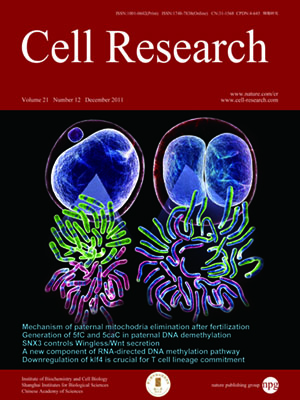
Advanced Search
Submit Manuscript
Advanced Search
Submit Manuscript
Volume 21, No 12, Dec 2011
ISSN: 1001-0602
EISSN: 1748-7838 2018
impact factor 17.848*
(Clarivate Analytics, 2019)
Volume 21 Issue 12, December 2011: 1711-1722
Marta Zwiewka1,2, Elena Feraru1,2, Barbara Möller3, Inhwan Hwang4, Mugurel I Feraru1,2, Jürgen Kleine-Vehn1,2, Dolf Weijers3
1Department of Plant Systems Biology, VIB, Technologiepark 927, 9052 Gent, Belgium
2Department of Plant Biotechnology and Genetics, Ghent University, Gent, Belgium
3Laboratory of Biochemistry, Wageningen University, Wageningen, The Netherlands
4Division of Integrative Biosciences and Biotechnology, Pohang University of Science and Technology, Pohang, Korea
Correspondence: ří Friml,(jiri.friml@psb.vib-ugent.be)
Subcellular trafficking is required for a multitude of functions in eukaryotic cells. It involves regulation of cargo sorting, vesicle formation, trafficking and fusion processes at multiple levels. Adaptor protein (AP) complexes are key regulators of cargo sorting into vesicles in yeast and mammals but their existence and function in plants have not been demonstrated. Here we report the identification of the protein-affected trafficking 4 (pat4) mutant defective in the putative δ subunit of the AP-3 complex. pat4 and pat2, a mutant isolated from the same GFP imaging-based forward genetic screen that lacks a functional putative AP-3 β, as well as dominant negative AP-3 μ transgenic lines display undistinguishable phenotypes characterized by largely normal morphology and development, but strong intracellular accumulation of membrane proteins in aberrant vacuolar structures. All mutants are defective in morphology and function of lytic and protein storage vacuoles (PSVs) but show normal sorting of reserve proteins to PSVs. Immunoprecipitation experiments and genetic studies revealed tight functional and physical associations of putative AP-3 β and AP-3 δ subunits. Furthermore, both proteins are closely linked with putative AP-3 μ and σ subunits and several components of the clathrin and dynamin machineries. Taken together, these results demonstrate that AP complexes, similar to those in other eukaryotes, exist in plants, and that AP-3 plays a specific role in the regulation of biogenesis and function of vacuoles in plant cells.
Cell Research (2011) 21:1711-1722. doi:10.1038/cr.2011.99; published online 14 June 2011